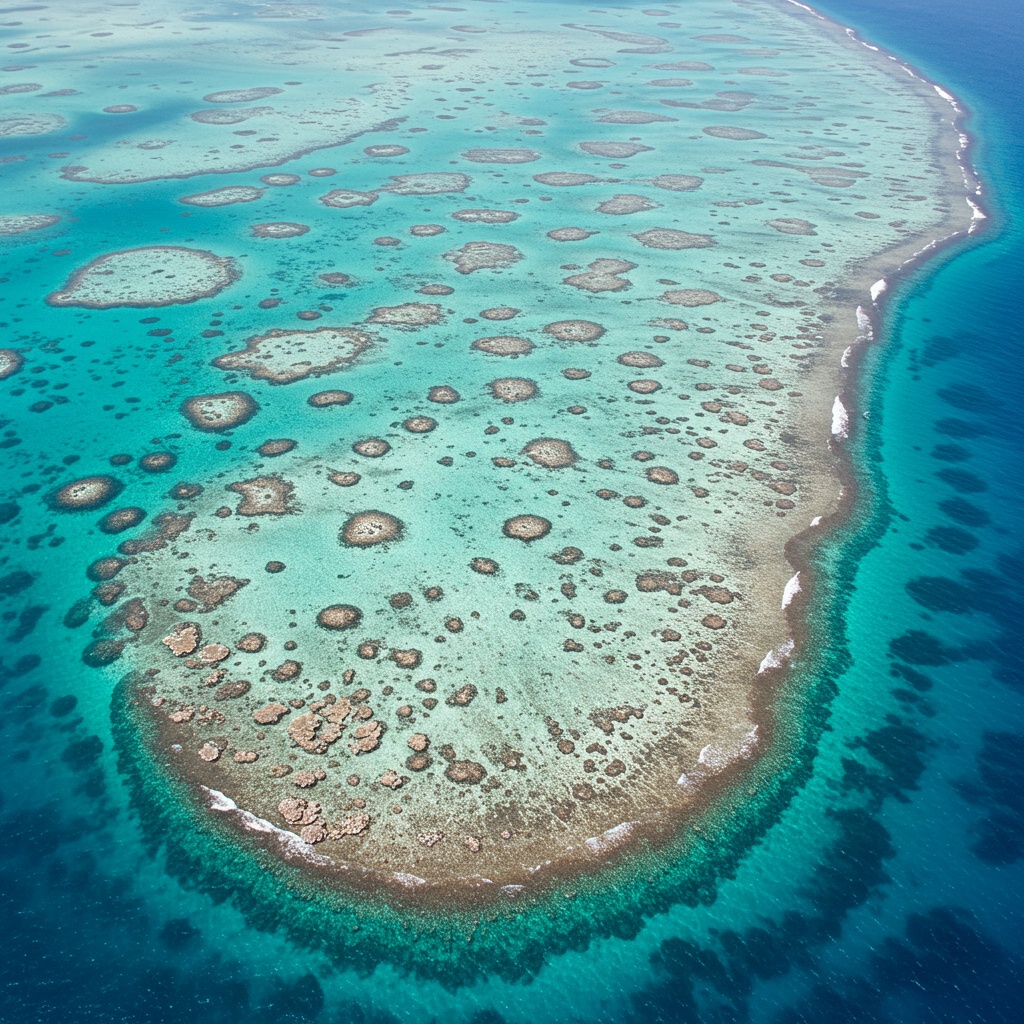Australia’s Great Barrier Reef, a global icon of marine biodiversity, is facing an unprecedented crisis. Recent research using cutting-edge drone technology has unveiled catastrophic coral mortality rates at a key location, highlighting the devastating impact of rising ocean temperatures. This study paints a grim picture for the future of these vital ecosystems, underscoring the urgent need for climate action.
The findings, published in the journal Coral Reefs, detail the severe damage inflicted during the 2024 Fourth Global Coral bleaching Event. Focusing on Lizard Island in the northern Great Barrier Reef, scientists documented some of the highest coral death rates ever recorded worldwide. The scale of loss revealed by high-resolution drone imagery has shocked researchers and amplified concerns about reef resilience in a warming climate.
Drones Reveal Devastation on a Grand Scale
A pivotal element enabling this alarming discovery was the strategic deployment of drone technology. Researchers utilized models like the DJI Mini 3 Pro and Autel Evo II. These advanced drones captured incredibly detailed imagery of reef sections. Critically, they surveyed the same areas before, during, and after the 2024 bleaching event.
This allowed scientists to track changes with unparalleled precision. Professor Jane Williamson, a senior author on the study, emphasized the technology’s advantage. “Using drone-derived imagery, we followed the amount of bleached and living coral during and after the bleaching event,” she explained. This capability enabled researchers to scale observations over vast areas. Yet, they retained high-resolution detail. Drone technology proves invaluable for monitoring remote or difficult-to-access reef areas. It provides a comprehensive overview of reef health.
Unprecedented Coral Mortality Rates
The data collected presents a sobering reality. Dr. Vincent Raoult, the study’s lead author from Griffith University, described the findings as catastrophic. He stated that the observed mortality marks one of the highest rates documented globally. Across the 20 surveyed 10m x 10m reef sections at Lizard Island, average coral mortality reached an alarming 92%.
At the peak of the bleaching event in March 2024, 96% of living corals in these areas were bleached. By June 2024, death rates surpassed 99% in certain specific sites. This level of devastation is particularly concerning for Lizard Island. It has historically been considered a relatively resilient part of the Great Barrier Reef. The reef there had shown signs of recovery from previous disturbances. This included severe bleaching events in 2016 and 2017. Impacts from cyclones and Crown-of-Thorns starfish outbreaks had also occurred.
High Death Rates Despite Moderate Heat Stress
Perhaps the most alarming finding is the context of this mortality. The unprecedented death rate occurred despite Lizard Island experiencing only moderate heat stress during the 2024 event. Heat stress was measured at approximately 6°C weeks in this location. This was lower compared to other parts of the Great Barrier Reef at the same time. This highlights the extreme sensitivity of coral ecosystems. Even modest increases in ocean temperature can trigger widespread and potentially irreversible damage. It demonstrates that prior stressors may have significantly reduced the reef’s capacity to cope.
The 2024 event represents the fifth mass bleaching event on the Great Barrier Reef in just eight years. Parts of the reef experienced extreme heat stress during the summer preceding this study. Aerial surveys indicated nearly one-third of the entire Great Barrier Reef experienced “very high” and “extreme” bleaching levels. This shows the broad impact of the heatwave.
A Broader Crisis: Record Ocean Temperatures
These specific findings at Lizard Island align with broader research indicating a climate crisis for the Great Barrier Reef. A separate study published in Nature revealed ocean temperatures in the GBR region reached their hottest in at least 400 years during early 2024. This research used analysis of long-lived coral skeletons. It reconstructed historical temperatures back to 1618.
The study found the January to March 2024 period was 1.73°C hotter than the pre-1900 average. This research firmly links these extreme temperatures to human-caused greenhouse gas emissions. Climate models confirm these heat extremes would not occur without anthropogenic warming. Experts describe this as an “existential threat” to the reef. It is a modern phenomenon driven by human activity.
Similar devastating bleaching events have been reported elsewhere in Australia. Western Australia’s Ningaloo Reef also suffered significant bleaching in early 2024. This was linked to a marine heatwave. Scientists observed widespread bleaching affecting even ancient, normally resilient Porites coral colonies there. This indicates the widespread nature of the threat. The bleaching impacts fragile ecosystems across different regions.
Long-Term Threats and the Need for Action
The severe mortality rates have profound implications for marine life. Coral reefs support an immense array of species. They provide crucial habitats and food sources. The loss of coral cover leads to a collapse in biodiversity. This affects fish populations and other organisms. Beyond the ecological impact, there are significant socioeconomic consequences. Communities reliant on the reef for tourism and fishing face severe economic hardship.
The research team is continuing to monitor Lizard Island. They are tracking potential recovery over the next several years. This work is funded in part by the Australian Museum Lizard Island Critical Grant. Recovery, however, is a slow and uncertain process. Following such high mortality, it could take decades, if not longer, for reefs to bounce back, if they can at all.
Seeking Resilience and Management Strategies
Despite the grim outlook, researchers are also seeking signs of hope. During the Ningaloo bleaching event, scientists noted some individual coral colonies remained unaffected. These resilient corals offer valuable avenues for study. Understanding their genetic makeup could inform future restoration efforts. Identifying and propagating heat-tolerant strains might be crucial.
Experts are calling for increased climate action and proactive management. Cutting greenhouse gas emissions rapidly is paramount to slow warming oceans. Locally, measures like temporarily restricting fishing in sanctuary zones could help boost ecosystem health. Increased visitor education about reef conservation is also vital. The evidence from Lizard Island adds weight to calls for governments to release timely data on coral mortality. This transparency is needed to inform conservation strategies. The science is clear: without immediate and ambitious action, the future of the Great Barrier Reef and other coral ecosystems worldwide remains critically endangered.
Frequently Asked Questions
What did the drone study find about coral death at Lizard Island?
A recent study using drone imagery revealed catastrophic coral mortality at Lizard Island on the Great Barrier Reef following the 2024 bleaching event. Average mortality reached an unprecedented 92% in surveyed areas, with over 99% death in some sites. This is one of the highest rates ever recorded globally, occurring despite the area experiencing only moderate heat stress compared to other parts of the reef.
How did drones help researchers study the Great Barrier Reef bleaching?
Researchers used high-resolution drone imagery captured by models like DJI Mini 3 Pro and Autel Evo II. Drones allowed them to survey large areas of the reef with high precision before, during, and after the bleaching event. This provided unparalleled ability to track the extent of bleaching and subsequent coral mortality over time, especially in areas difficult to access by traditional means.
What are the long-term impacts of this coral mortality on the Reef?
The high coral mortality has severe long-term impacts. It devastates marine biodiversity by destroying essential habitats for countless species. It also threatens socioeconomic stability for communities relying on reef tourism and fishing. Recovery from such widespread death could take decades, if ever, reducing the reef’s resilience to future heat events. It underscores the existential threat posed by climate change to coral ecosystems globally.



